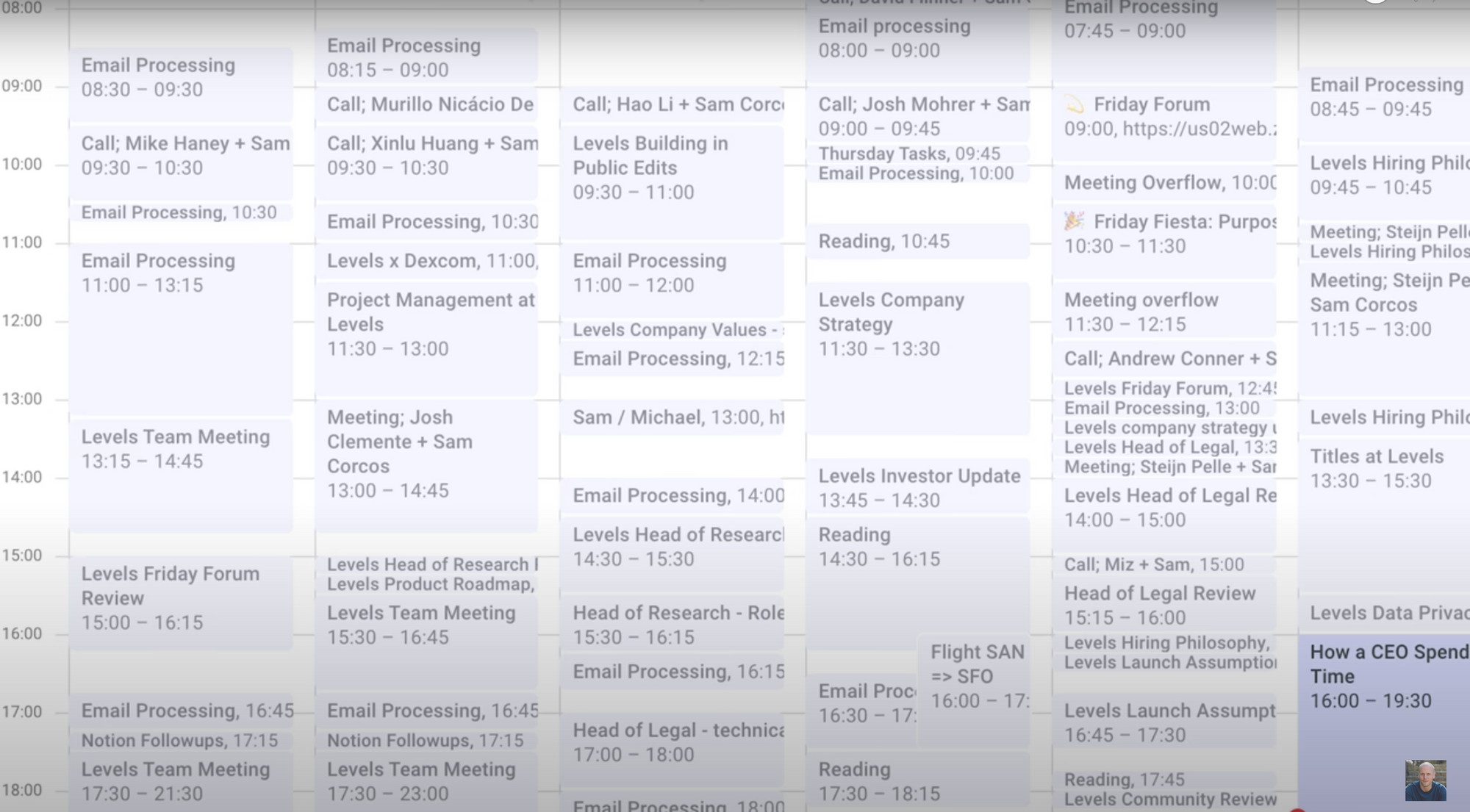Using your calendar instead of a to do list is the single most important time management tactic.
That's what Sam Corcos believes.
Sam is the CEO and co-founder of Levels. Levels is a startup that shows you how food affects your health by using CGM (Continuous Glucose Monitor).
Sam’s interview on The Tim Ferriss Show fascinated me recently.
He provided a tactical masterclass on delegation.
The interview is the most comprehensive guide to creating leverage with tools, systems and processes.
As a result, I’ve broken down some of the lessons around time management so that I can use them in my own routine.
Choose the right constraint
We tend to be overly optimistic about how much we can achieve in a day.
To measure how much work you can actually get done in a day, try this:
- Take everything on your to do list with that dates that you think they’ll get done by; and
- Put them on your calendar with the amount of time you think it’s going to take.
Simple enough.
The results might surprise you.
Was there enough time to fit all the items in your week?
The likely answer is “No”.
And that’s the point of the exercise.
“Your time is finite and the number of digital items you can add to your to-do list is infiite.”
- Sam Corcos
When we use a to do list, we’re working with the wrong constraint. You can add an endless amount of tasks to a to do list.
Instead, working with your calendar limits the number of things you can fit into a finite amount of time.
Give yourself some slack
As the CEO of a fast growing startup, Sam understands the benefits of having slack in your day.
Things often come up, which is why you need open time in your calendar.
It’s a concept he picked up from manufacturing. Whatever the assembly line, you need to have slack in the system to operate effectively.
Something will come up. If that one thing disrupts everything downstream, you have a problem.
It’s easier to pull tasks from tomorrow to today because you have slack in your day.
Without this, you face problems when one thing changes in your schedule.
Everything breaks.
Sam recommends aiming for 50% slack in your day, whether that’s tomorrow or three weeks from now.
As you use this system, you’ll get better at estimating how long it will take you to complete a task.
Retroactively updating your calendar helps with this process. It gives your the opportunity to review how long it takes to complete tasks.
Over time, you’ll improve this skill and gradually you can reduce the amount of slack.
In Sam’s case, he’s been operating this system for over 5 years and manages 25% slack in his day.

Manage emails in your calendar
Responding to emails is daily recurring task.
I’ve tried different ways to manage my inbox, with varying degrees of success.
When you have a stack of unopened emails, it could take 15 minutes or 15 hours to answer them. You have no idea until you read each email and figure out how much work it is.
Why not use the same process as your to do list and move emails to your calendar?
Schedule time in your day to check your emails. Open each one and consider how long it will take to respond.
Mark the email as read and put the link in your calendar with the expected response time.
Clearing your inbox becomes an exercise in scheduling the proper amount of time to reply to things.
This process will save you time because you touch each email only twice.
Once to read and allocate time and once to respond.
“You’re not looking at this undifferentiated stack of shit, that you are opening multiple times, marking as unread, going back to, forgetting what you read, reading it the 17th time, or whatever that might be.”
- Tim Ferriss
By scheduling emails into your calendar, you can manage time sensitive replies.
For example; if an email comes in today and you block of time on Tuesday to respond, you can tell that person “Hey, I’ll get back to you on Tuesday”.
If something comes up and you need to move the reply to Friday, you can now say “Hey, something came up, I’ll get back to you on Friday.”
That way, you keep people in the loop instead of dropping the ball.
Keep it simple
Add every new task to your calendar.
When you get asked to do something:
- Find out how soon they need it;
- Determine how long it will take you to complete;
- Check your calendar for an open slot relevant to the time required; and
- Confirm when you’re able to complete the task by.
For recurring tasks, include scheduled blocks in your calendar every day.